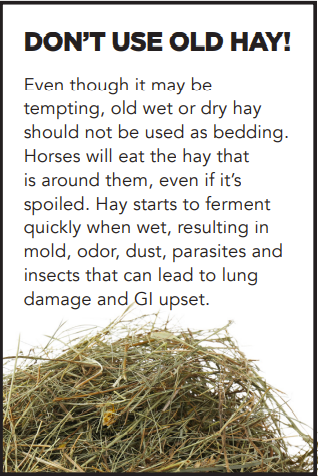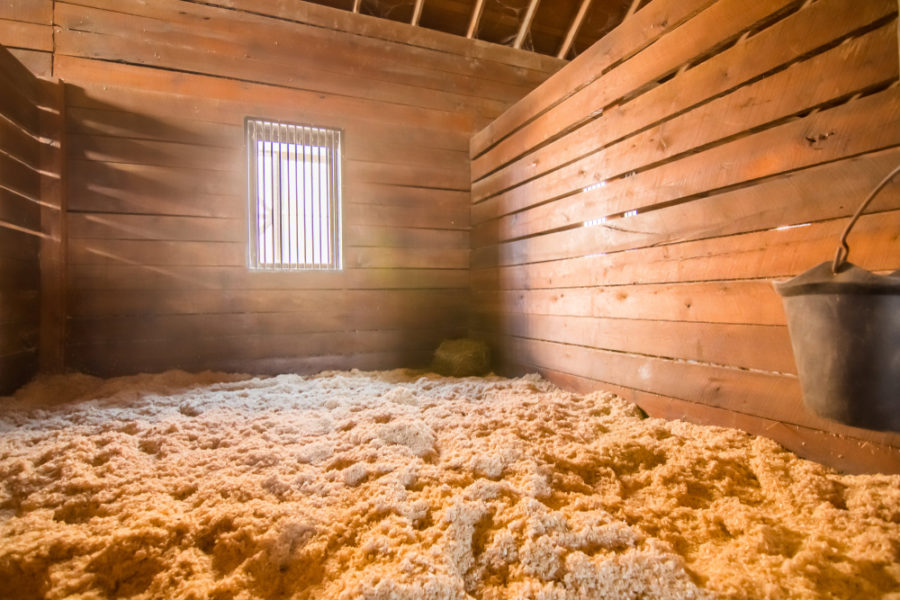Let’s take a look at some bedding options that can help improve comfort and sleep patterns in your horses.
The advantages of being educated on making better bedding choices are substantial and very much needed to ensure the best living conditions for the horse and ease of use for care takers. It’s easy to stay stuck in old patterns when it comes to making bedding choices, but times have changed and there are new options readily accessible. By researching options, caretakers can increase comfort, improve the composting process, save time and money, and see fewer health problems for both horses and humans. In fact, taking a more in-depth look into the many varieties of bedding could change the way that stall mucking is done and enhance the quality of life for horses who spend any amount of time in a stall.
Rubber stall mats
Using stall mats will not only add comfort to a stall floor but also give enough cushioning effect to better support a horse’s movements that makes standing, getting up and laying down less stressful. Ideally, additional bedding should be used on top of rubber mats, as mats alone can make for a dangerous slippery surface. That said, using mats keep bedding waste to a minimum and makes cleaning stalls simpler as manure and soiled bedding is easier to scoop up.
Wood sawdust and shavings
Sawdust is a more finely processed wood bedding compared to thicker shavings and wood chips. The traditional and safer woods used are typically from pine and fir. Finer sawdust covers more surface area than shavings and heavier wood trimmings, but finer also means dustier. To avoid horse and human respiratory problems and potential fire hazards, a good ventilation system and cleaning routine is needed when using loose wood bedding.
Be sure to check with a veterinarian or other knowledgeable resource on wood bedding materials as many are toxic to horses. Black walnut wood, for instance, can trigger laminitis in a very short time. Using 100% cedar wood in a stall isn’t recommended, since the oil in the wood can cause allergic skin reactions and pull moisture from a horse’s hoof. Chipped landscaping material from tree trimming services is also not recommended especially those used in landscaping (such as black walnut, black locust, parts of oak trees, horse chestnut, etc.).
Wood pellets
Other types of wood products can make excellent bedding materials. Absorbent low dust forming pellets are gaining popularity. Made of kiln-dried wood (usually fir, alder and pine), the fine material is compressed into a small hard pellet that expands back to sawdust once in contact with water. Mucking a stall with wood pellet bedding will feel more like cleaning a cat’s litter box as the texture is quite similar. Pellets are usually sold by the bag which makes transporting and storage easy. Some brands contain natural zeolite additives to help with odor control and reduce ammonia in the stall and in the air. Zeolite products are also a good addition to a compost pile as they slowly release nitrogen back into the soil. Wood-stove pellets may be cheaper than pelleted bedding and usually sold at feed stores, as well as some grocery stores and home improvement centers. When buying wood-stove pellets, be sure they contain 100% wood product, with no glue or chemical additives.
Peat moss
With a strong devoted equine following due to the high absorbency and softness, peat moss adds many benefits to compost piles, gardens and pastures. Drawbacks of the very fine organic material is the dust it creates in drier and windier climates. Some horse caretakers find the dark, dirty look of peat bedding unsatisfactory, while others may have to pay a large shipping fee to obtain this material depending on their location.
Straw
Wheat or oat straw is used as a barrier to protect manure and urine from the stall floor. It takes a deep, thick bed of straw to maintain a clean, dry barrier – however, straw can be less dusty than wood bedding if it’s harvested and stored correctly. A bale of straw needs to be checked as closely as hay for signs of moisture and mold. While straw is less palatable than hay, horses will consume it and eating straw can lead to problems such as impaction colic or mouth irritation from the barbed seeds that were left on the plant from harvesting. Respiratory issues can develop and the problems with ammonia accumulation in the barn are greater due to the poor absorbency of straw.
Shredded paper
Paper has several properties that provide a completely dust- and foreign object-free bedding choice for horses and caretakers who have allergies or respiratory problems. Unfortunately, is not widely available and can be a messy to handle. Paper bedding is usually made from unused newspaper stock cut or torn into strips that won’t cut skin. Shredded paper composts are one of the most compostable options in bedding.
Sand
Having a horse under sand in hot dry climates makes sense as urine and moisture drains well with easy clean-up. Sand is popular for outside shelters and stalls but it isn’t the safest choice due to the fact that horses will inhale and ingest sand particles when eating off of the ground, causing a high risk of sand colic and impaction as they pick through hay and grain that drops or spills.
Kenaf
One of the newest alternative bedding products is an experimental agricultural product being grown in the southeastern US with agricultural roots that trace back 4,000 years through Africa and India to Egyptian times. Kenaf, which is related to cotton and okra, is a fast-growing fibrous plant that has many uses, including making paper. When grown, the stem core is suitable as animal bedding, resembling spongy kitty litter or cereal. It’s reported to be highly absorbent, dustless, non-allergenic and extremely biodegradable.
Bedding is an individual choice
Here are a few things to consider when choosing bedding for your horse:
Time – Horses confined to a stall will require more bedding in order to absorb urine than horses who have ample turnout time.
Storage – Storing bedding material is a major consideration for caretakers short on space, whereas those with extra room with easy access for delivery trucks can buy in bulk.
Dust and mold – Horses and caretakers with respiratory issues such as allergies or asthma will need an absorbent bedding with low dust, mold and foreign object counts. The bedding’s ability to reduce ammonia in the space should also be considered.
Managing waste – Many caretakers prefer bedding that breaks down faster and more completely. If depositing waste straight to the land, the big concern is the amount of carbon produced, which all bedding creates. Too much carbon dumped onto pastures will rob soils of nitrogen turning pasture plants yellow.
Availability – Investigate bedding types and sources available locally. Take the time to do the homework to shop around and ask questions.
Weather – Different climates can bring different hardships to bedding choices. Knowing what works best in your area, and understanding the challenges of the changing season ahead of time will make for smooth transitions.
Cost – Many products are more expensive pound for pound, but if they’re highly absorbent then less is used. Buying in bulk usually saves money.
The nuisances of bedding and stall environments
No matter what the preferred bedding choice is, horse caretakers have an important job when it comes to their horse’s daily living conditions. Dr. Rohn Hendricks, DVM, has owned Complete Mobile Equine Veterinary Services since 1999 in Waxahachie, Texas and shares that biting mites, lice and insects that live in or around bedding aren’t an easy problem to fix. “Just like fleas on a dog, owners have to break the cycle and treat the horse and its environment.,” he says. “Depending on the severity of symptoms the horse is exhibiting, a veterinarian should be called to access any skin problems spurred by bedding and other environmental situations. Allergies, reactions and irritants can cause more than just itching and with secondary skin infections that can leave horses with open, bleeding, raw irritated skin or trap bacteria under forming scabs. I sometimes use a product called Apoquel that breaks the itch cycle with long-lasting relief that target the specific proteins that cause the problem.
“Using a quality fly with broad killing insect spray can help keep the horse protected and more comfortable,” Dr. Hendricks continues. “Skin issues may take an antibiotic treatment, antihistamines and steroids to provide real relief. The plan for treatment will obvious depend on the allergic culprit and allergy testing is the best way to uncover the unknowns.”
The stall test
One simple test that Dr. Hendricks suggests is to put a fan in a dirty stall. Stand, sit and lay down in the stall, paying attention to what you feel, see, smell and breathe in.
“The position of the breeze the fan creates will only be felt when you’re in its direct path,” says Dr. Hendricks. That same breeze will only be felt by your horse when he stands. “You usually won’t breath in much bedding dust when standing up, or smell strong fecal or urine aromas.”
 “Next, sit down and move the bedding like a horse would at the level where your horse’s head and body will be moving, resting and eating. Usually the breeze fades and may not be felt at this level and bedding dust will land on your clothing and skin. There’s a good chance you smell fecal waste and urine too. Your nose may sting from the potent ammonia smell from the urine-soaked spots with no air flow and the dust of the bedding may come in direct contact with eyes, nose and mouth making it hard to take a deeper breath and possibly even irritating your airways. This is what your horse experiences day after day and if stall conditions aren’t kept clean with proper ventilation, the outcome could turn into serious health issues quickly.”
“Next, sit down and move the bedding like a horse would at the level where your horse’s head and body will be moving, resting and eating. Usually the breeze fades and may not be felt at this level and bedding dust will land on your clothing and skin. There’s a good chance you smell fecal waste and urine too. Your nose may sting from the potent ammonia smell from the urine-soaked spots with no air flow and the dust of the bedding may come in direct contact with eyes, nose and mouth making it hard to take a deeper breath and possibly even irritating your airways. This is what your horse experiences day after day and if stall conditions aren’t kept clean with proper ventilation, the outcome could turn into serious health issues quickly.”
Making a stall a home
Every horse deserves a comfy stall to feel pampered and spoiled in. Weighing the factors that make for a safe and relaxing stall condition can get complicated for caretakers, but making the horse’s comfort and overall health a priority will guarantee a secure and pleasant space – for them and for you!








